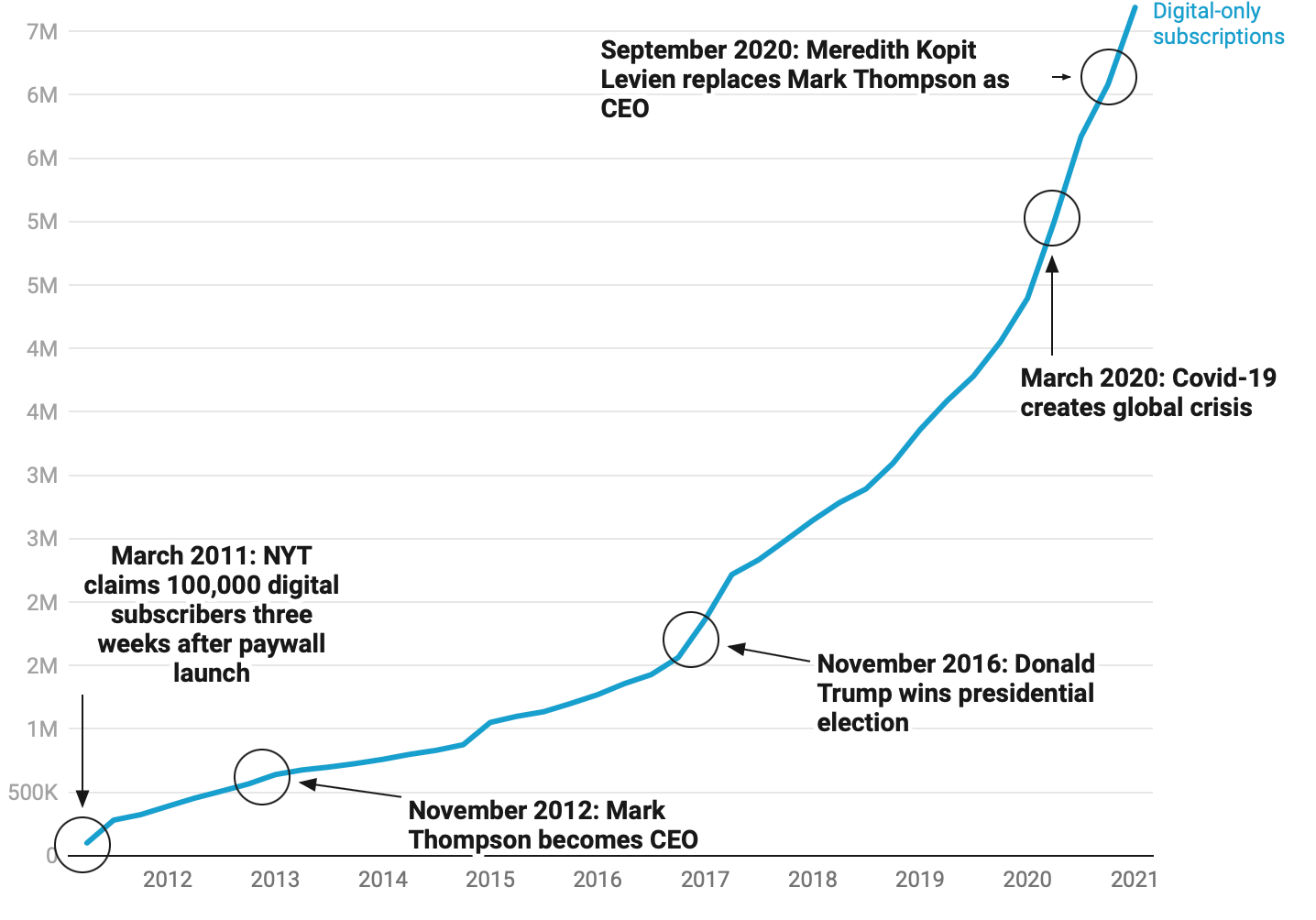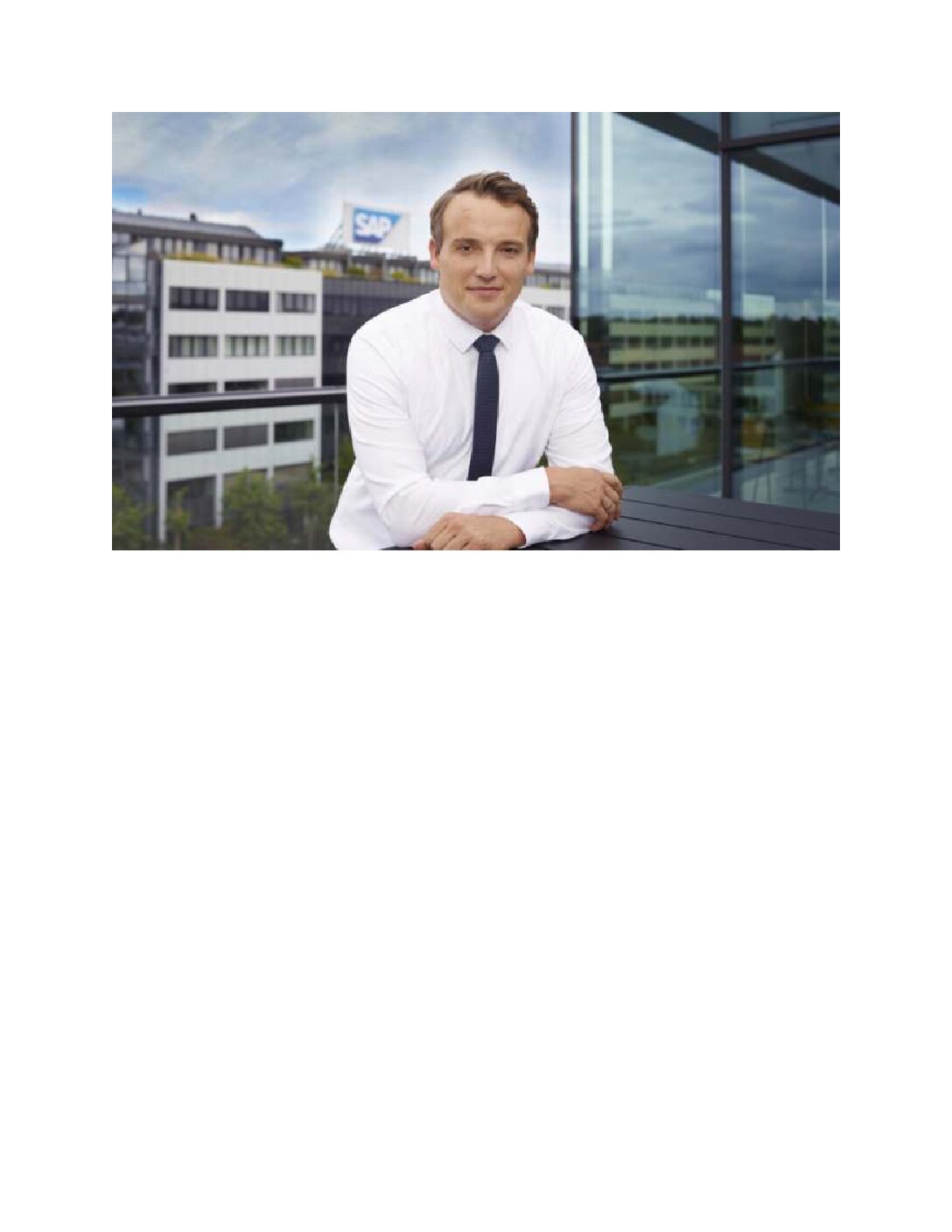Fake news. Failing. Discredited. Corrupt. An embarrassment to journalism.
These are just a few of the words and phrases Donald Trump used to describe the New York Times during his four years in the White House.
So it is slightly surprising to hear that the now former president made an effort to get off on the right foot with Mark Thompson, who was chief executive of the New York Times from 2012 through to September last year.
“He rather disarmingly said to me: ‘I’ve heard about you. You’re a very important man,’” says Thompson, recalling an on-the-record meeting he and colleagues had with Trump in November 2016, after his election and before his inauguration into the White House.
Clearly, the relationship did not blossom. But despite Trump’s regular Twitter tirades against the Times, his presidential tenure coincided with a golden period for the Gray Lady. Between September 2016 and December 2020, the newsgroup’s digital subscriptions grew from 1.6m to 6.7m. (As a result, the NYT is the runaway leader of Press Gazette’s 100k Club league table, which ranks English-language news publishers by digital-only subscription numbers.)
Thompson, a former BBC director-general who left London for New York in 2012, admits that the Times was a major beneficiary of the so-called “Trump Bump”.
But speaking to Press Gazette via Zoom from his house in Maine, Thompson tells how the NYT had spent the years before Trump’s unlikely victory building up its digital subscription offering. “And that meant that in 2016, when the election happened and Trump got elected, we were more ready than anyone else.”
How Thompson, Trump and Covid helped the New York Times reach 7m digital-only subscribers

“I had quite a lot of scepticism inside the building”
Born in London and educated at Oxford, Thompson started his career at the BBC as a production trainee in 1979. He rose through the ranks of the corporation to become director of television before moving to Channel 4 as chief executive in 2002. Thompson then moved back to the BBC to serve as its director-general between 2004 and 2012.
When Thompson joined the New York Times in November 2012, the news outlet’s paywall was in its infancy, with around 600,000 digital subscribers (see chart above). The online subs business grew steadily in the following years, but Thompson says there was external doubt about whether the NYT could succeed.
“People then thought, I think, that it might have an application for business news,” he says. “They looked at the Wall Street Journal and the FT, and they said: ‘Well, maybe people can expense those and it’s a professional thing.’ But there was a lot of scepticism about whether you could really scale a general news proposition.”
Although there were other digital publications disappearing behind paywalls – like News Corp’s Times and Sunday Times in the UK – Thompson believes the consensus of the industry was that consumers were unwilling to pay for online news because it “was available for nothing on the internet”.
“I think that’s a misunderstanding of what news is,” says Thompson. “I think news is quite a rich thing. You’re quite interested in the newspaper it’s coming from, maybe even the reporter it’s coming from.
“You’re interested in: Has the report got something new in it? Is it investigative journalism?
“And I think the industry didn’t pay close enough attention to what was going on. And weirdly they forgot that most reputable newspapers had got a lot of their revenue from circulation, from cover price.”
Were there many doubters within the New York Times?
“I had quite a lot of, as it were, scepticism inside the building,” says Thompson. “They’d launched the third attempt at a pay model – the successful one, the one the Times has still got – just over a year earlier before I arrived. And most people thought there was something there for the Times, but they thought it was going to be about half a million, 600,000.
“They’d spent essentially 15 years or so building up a loyal online following. Some of that had been the historic readers of the physical paper. Many of them were still reading the paper but also looking online. And it had picked up a few hundred thousand more. But they thought that the model was going to plateau. And, in fact, when I got there it looked like it was plateauing.”
He adds: “And I just thought we weren’t doing it well enough, and we weren’t doing it smart enough and we weren’t using data properly and all the rest of it.”
Between 2012 and 2016 Thompson reorganised the company, appointed new leaders and hired teams of engineers and data scientists tasked with improving the experience of reading the New York Times, especially on mobile devices.
Ad-funded online news ‘is going to go through a difficult period’
Today, many large English-language ‘broadsheet’ newspaper groups have put their websites behind paywalls. One notable exception is the Guardian, which is free to read but has 900,000 paying online readers thanks to its premium apps and donations model.
Back in 2014, then Guardian editor Alan Rusbridger dismissed paywalls as a “19th-century business model”. Criticising the paid-for website of the London-based Times in particular, he said: “I don’t know of a single journalist – a single journalist – who would prefer to have a closed model.”
Thompson says he experienced “a little bit of that” kind of dissent at the New York Times. But he points out that the New York Times does make much of its content freely available – its Covid-19 coverage was made free last spring, and it produces free podcasts and other multimedia products.
Addressing Rusbridger’s seven-year-old comments (which he easily recalls), Thompson says: “I think that was a slightly false choice, honestly. The [New York Times], I believe, reaches as many people with free journalism as the Guardian does. But, unlike the Guardian, the Times has been able to add 300 extra journalists to its newsroom because it’s got this pay model.
“I don’t think even Alan believes you should give the physical Guardian away for nothing. Perhaps he does!? I don’t know. What’s the difference?
“Everyone knows that a physical paper costs something to make, so you have to pay for it. But actually, a digital news report costs something to make as well. And the fact that it’s virtual doesn’t mean it doesn’t cost anything to make.”
For the record, Thompson says he is a paying reader of the Guardian, as well as the New York Times, the Financial Times, the Times of London, the Wall Street Journal, the Economist and “a few more” – “I practice what I preach!”
Aside from the Guardian – which is reliant on reader contributions – does Thompson think other free-to-access, advertising-funded news websites can succeed? Mail Online, with revenues of £144m ($200m) last year, seems to be doing well.
“Mail Online’s built up an extraordinary audience,” says Thompson. “I don’t look at it as often as the ones I’ve mentioned – I’m a creature of my age and background and all the rest of it. But when I do, it seems to be professionally done.
“My worry about it in pure business terms is that’s a crowded market. You’re competing against pretty adept digital-first companies like Buzzfeed. And crucially, [in] advertising revenue, you’re competing against companies with more data scientists and engineers and simply more audience. Facebook’s now between two and three million.
“What’s fascinating is that the big platforms have now got the kind of lock on the audience that newspapers used to have. And because of that, they’ve got pricing power – they basically control the market.
“Smart people can sometimes get an edge by understanding the way the big platforms’ algorithms work, but that’s getting harder and harder to do. It’s getting harder and harder to track people. All of the browsers and platforms and devices are making it harder – by the way, I think they’re right to be doing so – harder for advertisers or anyone else to track our behaviour and our movement.
“That’s making it harder to do higher CPM advertising. And so that whole industry is going to go through a difficult period. [Mail Online] is a great product and they get a fantastic audience. My question would be: how far can you drive the economics?”
Big Tech regulation? ‘I actually don’t terribly like regulators and governments getting involved in this
Advocates of the ad-funded news model will likely view Thompson’s assessment as overly pessimistic. Especially given that Google and Facebook are increasingly coming under – and ceding to – pressure to pay publishers a fair price for news.
With laws coming into force in Australia to make the Duopoly (Facebook and Google) pay for news content, News Corp has recently signed cash-for-content deals with the two tech giants.
Speaking last month, News Corp chief executive Robert Thomson predicted that the journalism industry is “about to get a second wind” because of the changing relationship between platforms and publishers.
Does Thompson agree?
“It’s very funny, Robert and I sometimes talk about this – I’m actually, to this extent, more free-market than he is,” he says.
“I actually don’t terribly like regulators and governments getting involved in this. I [don’t like] the idea of governments kind of in the end being able to pick winners, which is normally going to mean picking incumbents and might even mean picking incumbents who are politically useful or close to them if they’re politicians or regulators.
“I’ve myself preferred the idea of freely negotiated commercial partnerships between publishers and big platforms where the big platforms actually get something which is useful to them out of it.
“So it’s more of a commercial relationship than one which has been mandated by regulation.
“But I think it needs to happen. I think, by the way, the politics in Australia, in Europe – maybe even ultimately in the United States, and by the way probably in Canada as well – are heading in this direction.
“And when I talk to my friends at the big platforms I always say: ‘You know, if you don’t find a way through this voluntarily, it’s going to come anyway.’”
Thompson – who recently became a consultant to German publishing giant Axel Springer – acknowledges that he has always worked for large media companies. But he says: “I do worry about, as it were, just bailing out incumbents, if that makes sense. We want a lively industry where you can start from nothing and build something up. If we can’t grow new newspapers, then what have we got?”
“There are some real opportunities in journalism”
Thompson does have an interest to declare here. Along with former FT editor Lionel Barber, he recently backed a management buyout of the UK’s New European newspaper. (Press Gazette last week published an interview with New European owner/chief exec Matt Kelly.)
“It’s really interesting,” says Thompson of the New European, which was set up as a pro-EU newspaper by regional publisher Archant in the aftermath of the Brexit referendum.
“I joined it largely because of my friendship with a fellow co-conspirator,” says Thompson. Which one? “I’ll say no more than that.”
Does he expect to make any money from it? “Actually, I think it’s quite an interesting model,” he says, comparing it to the Spectator magazine.
“Nicely commissioned and curated, quite pungent journalism, very clear about what it’s trying to do, very clear about its audience, that’s actually quite interesting. It rather suits this moment in journalism, actually.
“So I think it’s very easy for doom and gloom to cover the entire landscape, wash a layer of ash over everything. I think it’s more complicated than that. There are some real opportunities in journalism as well.”
Is Thompson a passionate Remainer then?
“No. I’d say I was a pragmatic Remainer, in the sense that I thought on balance it made better economic sense to stay in than to leave. But I also absolutely accept the verdict of the 2016 referendum and want the UK to succeed outside Europe.”
In the run-up to the 2016 US election, Republican candidate Trump described his forthcoming victory as “Brexit plus”. Are Brexit and Trump part of the same phenomenon?
“I think it’s been, through my lifetime and certainly through my professional lifetime, a deep thread of British thought – a very deep thread,” he says. “And to that extent, I think it’s very different from Trump.
“I think some of the noise and some of – I wrote a book about this – the rhetoric around it I think is quite… there are some similarities in populist weapons and tactics. But I think the sources are quite different.”
Does the BBC undermine commercial newsgroups? ‘Not really’
As someone who has led the BBC, Channel 4 and the New York Times, Thompson is probably uniquely placed to comment on the differences between the UK and US journalism industries. What is the main one?
“I think in terms of the companies, it seems to be easier to do innovation and to get support for investment and risk-taking in America,” he says. “Somehow or other, the willingness to have a go – the acceptance that you may just have to grit your teeth and change and try new stuff – seems to work.”
Thompson says he was warned before joining the NYT that it was an “incredibly conservative place” – it faced an “enormous backlash” in the 1990s when the newspaper started including colour pictures, which were regarded as “grotesque dumbing down”, he says. But, in fact, he discovered a “real appetite for experimentation”.
Asked if he is concerned about the future of the BBC, Thompson laughs.
“I was concerned about it the day I joined it in 1979,” he jokes. “The BBC is always a worry.
“No, look, I’m a very big fan of [current director-general] Tim Davie. I think the BBC faces, as everyone in media does, some very big questions.” He cites competition with tech giants that have “very deep pockets – realistically, in a fight with Netflix for the Crown, Netflix is going to win”.
The other major issue Thompson identifies is: “How do you engage younger audiences? How do you make sure you don’t end up locked into older generations and, if you like, your more obvious near-to-hand audiences, which in the UK might be more southern, more prosperous, more white… and older audiences? How do you reach out to other groups?
“Because if you can’t demonstrate broadly universal appeal and value, you won’t justify the licence fee. I think although that was something we were wrestling with when I was running BBC television and running the BBC… that problem’s getting tougher, not easier.”
Thompson says the return of BBC Three is “actually a very positive step” in the right direction, and believes the licence fee funding model still works. But he is concerned by statistics that show the average BBC One viewer is in their 60s. “That drift is a dangerous one for the BBC,” he says.
Having now worked on the commercial side of news, does Thompson have any sympathy with the UK news industry argument that the BBC is too large and harms the private sector?
“Not really,” he says. “I honestly think that the point about the internet is there’s a lot of stuff out there. And rather than trying to blame other people, or stop other people – or basically look to the government to help you out by stopping something else happening – you have to dig deep and find [your] own way.”
US newspaper companies, he points out, “have got all the same problems”.
“There’s absolutely no evidence that you take the BBC out of the way in the UK and suddenly advertising revives or that actually more money comes in.
“There’s some loose idea that there would be more engagement, but actually the truth is it’s the fundamental economics of advertising… and competition from other people who are offering advertising, like Google and Facebook, rather than the BBC as such.
“So honestly, no. I think it’s a red herring. This is happening across the world… I think it’s displacement activity, to be honest.
“The people who are succeeding aren’t doing that by badgering the government to try and shut down competitors or to shut down public service broadcasting. They’re doing it by fixing their models.”
Full article on Press Gazette UK


